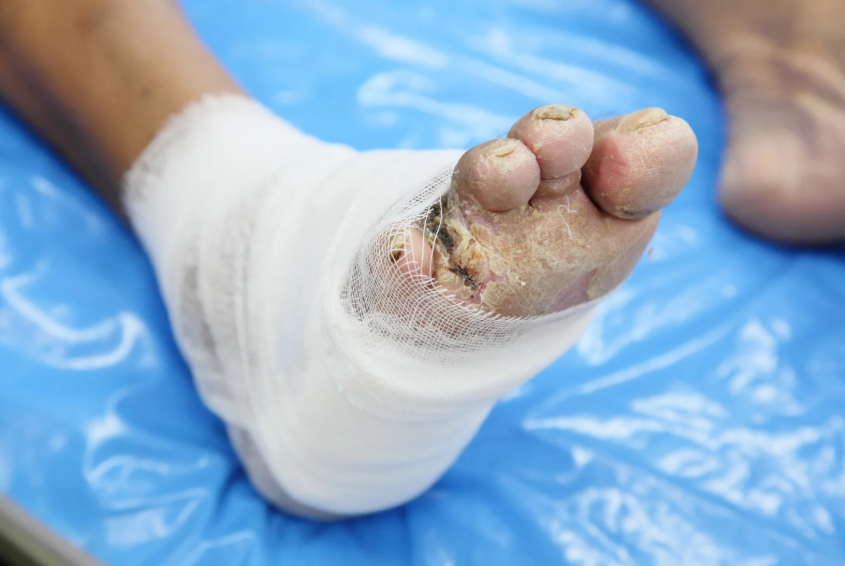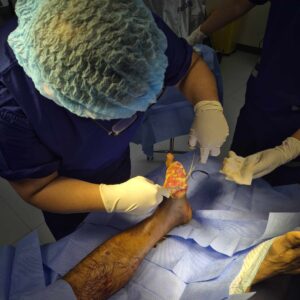Diabetic foot disease is a serious complication that affects individuals with diabetes, often leading to mobility issues, chronic wounds, and in severe cases, amputations. Without proper intervention, the condition can significantly impact a person’s quality of life. Orthopedic treatment for diabetic foot disease plays a crucial role in addressing these complications, offering solutions that promote healing, improve mobility, and prevent further deterioration. Personalized care is essential in ensuring that treatment is tailored to an individual’s specific needs, maximizing recovery and reducing the risk of severe complications.
Understanding Diabetic Foot Disease
Orthopedic treatment for diabetic foot disease begins with a thorough understanding of the condition. Diabetic foot disease develops due to prolonged high blood sugar levels, which damage nerves and blood vessels in the feet. This leads to reduced sensation, poor circulation, and an increased risk of infections.
Common complications of diabetic foot disease include neuropathy, foot ulcers, infections, and deformities. Peripheral neuropathy causes a loss of sensation, making it difficult for patients to detect injuries. Poor circulation slows down healing, increasing the risk of chronic wounds and infections. If left untreated, severe cases may require amputation. Orthopedic treatment for diabetic foot disease focuses on preventing these complications and promoting long-term foot health through personalized care.
The Role of Orthopedic Treatment in Diabetic Foot Disease
Specialized care is crucial in managing diabetic foot complications. Orthopedic treatment for diabetic foot disease is designed to address structural and functional foot problems, helping to reduce pressure points, enhance mobility, and prevent complications.
Orthopedic specialists assess foot biomechanics to identify abnormalities that contribute to foot ulcers and deformities. They provide interventions such as custom orthotics, footwear modifications, and bracing solutions to alleviate pressure on sensitive areas. By addressing these issues early, orthopedic treatment for diabetic foot disease reduces pain and enhances the patient’s ability to move comfortably.
Personalized Care Approaches for Effective Healing
Custom Orthotics and Footwear
One of the most effective strategies in orthopedic treatment for diabetic foot disease is the use of custom orthotics and specialized footwear. These devices help redistribute pressure evenly across the foot, reducing stress on high-risk areas prone to ulcers.
Orthopedic specialists design custom insoles and diabetic shoes that provide cushioning and support, preventing excessive friction that can lead to wounds. Offloading devices such as total contact casts or removable walkers are used to promote healing in patients with existing foot ulcers. By integrating these solutions, orthopedic treatment for diabetic foot disease helps prevent further complications while improving patient comfort.
Wound Care and Infection Control
Proper wound management is essential in orthopedic treatment for diabetic foot disease to prevent infections and promote healing. Advanced wound care techniques, including specialized dressings, negative pressure therapy, and skin grafts, help accelerate tissue repair.
Orthopedic specialists perform debridement, a process that removes dead tissue to encourage healing. Antibiotic treatments are also prescribed to control infections and prevent their spread. Personalized care ensures that each patient receives the most effective treatment plan based on their wound severity and overall health condition. Through proactive wound management, orthopedic treatment for diabetic foot disease significantly reduces the risk of amputation.
Surgical Interventions When Necessary
In severe cases where conservative treatments are not effective, orthopedic treatment for diabetic foot disease may require surgical intervention. Surgical procedures aim to correct deformities, remove infected tissue, and improve foot function.
Common surgical options include bone realignment, joint fusion, and Achilles tendon lengthening to relieve pressure on the foot. For patients with severe infections, partial amputations may be necessary to prevent the spread of disease. However, early orthopedic intervention can often prevent the need for amputation. With personalized surgical approaches, orthopedic treatment for diabetic foot disease enhances mobility and quality of life.
Preventative Strategies for Long-Term Foot Health
Preventative care is a fundamental part of orthopedic treatment for diabetic foot disease. Patients are encouraged to adopt daily foot care routines to reduce the risk of complications.
Key preventative strategies include:
- Daily foot inspections to identify cuts, blisters, or infections early.
- Moisturizing the feet to prevent dryness and cracks that can lead to infections.
- Wearing properly fitted orthopedic shoes to reduce pressure points.
- Regular visits to an orthopedic specialist for foot assessments and early intervention.
- Managing blood sugar levels through a balanced diet and exercise to promote overall foot health.
By implementing these measures, patients can significantly reduce the likelihood of developing serious foot complications. Orthopedic treatment for diabetic foot disease not only focuses on healing but also on long-term prevention.
Takeaway
Effective management of diabetic foot disease requires a comprehensive approach that includes orthopedic treatment for diabetic foot disease and personalized care strategies. By incorporating custom orthotics, advanced wound care, and surgical interventions when necessary, orthopedic specialists help patients regain mobility and improve their quality of life.
Early intervention is key to preventing severe complications such as ulcers and amputations. Patients should seek regular orthopedic assessments and follow preventative measures to maintain long-term foot health. If you or a loved one is experiencing foot complications due to diabetes, consult an orthopedic specialist today to explore the best orthopedic treatment for diabetic foot disease tailored to your needs.
By prioritizing personalized care and proactive treatment, individuals with diabetic foot disease can achieve better outcomes and enjoy an improved quality of life.






